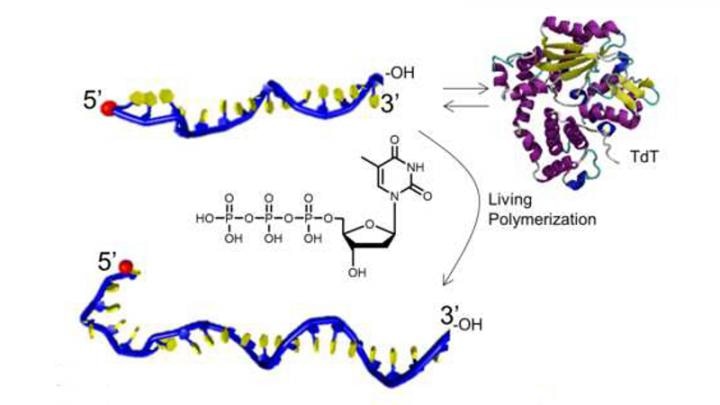May 17 2017
 New recipe uses overlooked DNA builder to simplify production of synthetic biomaterials for applications ranging from drug delivery to nanowires. Credit: Stefan Zauscher, Duke University
New recipe uses overlooked DNA builder to simplify production of synthetic biomaterials for applications ranging from drug delivery to nanowires. Credit: Stefan Zauscher, Duke University
A new recipe written by materials scientists explains the procedure for using an oddball enzyme to construct new biomaterials from DNA. The work provides instructions that can be used by researchers from all over the world in order to develop self-assembling molecules for applications ranging from nanowires to drug delivery.
The molecular machinery of the human body generally depends on genetic templates to execute the construction. For instance, molecular machines known as DNA polymerases read DNA base-by-base to produce accurate copies.
However, there are a few black sheep in the world of molecular biology that do not need a template. Terminal deoxynucleotidyl transferase (TdT), is one such outlier, which operates in the immune system and catalyzes the template-free addition of nucleotides to a single-stranded DNA. Nucleotides are the building blocks of DNA.
Even though there seems to be not much biological use of random nucleotide sequences in a single DNA strand, materials scientists have indeed discovered what to do with it.
Duke University researchers, in a new paper, have built on their earlier work and provide a detail description of how the TdT enzyme can develop precise, high molecular weight, synthetic biomolecular structures in a much more effortless manner than existing methods. Researchers can customize synthesis in order to produce single-stranded DNA that can self-assemble into ball-like containers for delivery of drugs or to incorporate unnatural nucleotides to allow access to variety of medically useful abilities.
The findings are presented in the May 15, 2017 issue of the online journal Angewandte Chemie International Edition.
We’re the first to show how TdT can build highly controlled single strands of DNA that can self-assemble into larger structures. Similar materials can already be made, but the process is long and complicated, requiring multiple reactions. We can do it in a fraction of the time in a single pot.
Stefan Zauscher, Sternberg Family Professor of Mechanical Engineering and Materials Science, Duke University
When compared to typical, synthetic chain-building reactions, TdT seems to be beneficial in once aspect referring to the fact that it continues to add nucleotides to the end of the growing chain as long as they are available. This indeed opens a vast design space to materials scientists.
All the enzymes never stop and they work at the same pace allowing the resulting strands of DNA to be almost of the same size, and this is considered to be a significant feature for controlling their mechanical properties. The never-ending process also explains that researchers can force-feed TdT any nucleotide they want, even unnatural ones, by just providing no other options.
Your body makes strands of DNA out of only four nucleotides—adenine, guanine, cytosine and uracil. But we can create synthetic nucleotides and force the enzyme to incorporate them. This opens many doors in making DNA-based polymers for different applications.
Ashutosh Chilkoti, the Alan L. Kaganov, Duke
For instance, unnatural nucleotides can integrate molecules designed to facilitate “click chemistry” in order to help in the attachment of a whole suite of biomolecules. It is also possible for researchers to begin the building process with a foundation made of a particular DNA sequence, known as aptamer, capable of targeting particular cells and proteins.
This enzyme has been around for decades, but this is the first time somebody has mapped these concepts into a blueprint for synthesizing a whole new family of polynucleotides. In the past, biochemists have largely been interested in what TdT does in the human immunological system and how it does it. We don’t care about all of that, we’re just interested in what material building blocks we can make with it. And the precision with which we can make polymers with this enzyme is actually quite exceptional.
Stefan Zauscher, Sternberg Family Professor of Mechanical Engineering and Materials Science, Duke University
The National Science Foundation (DMR-1411126 and DMR-1121107) supported this work.